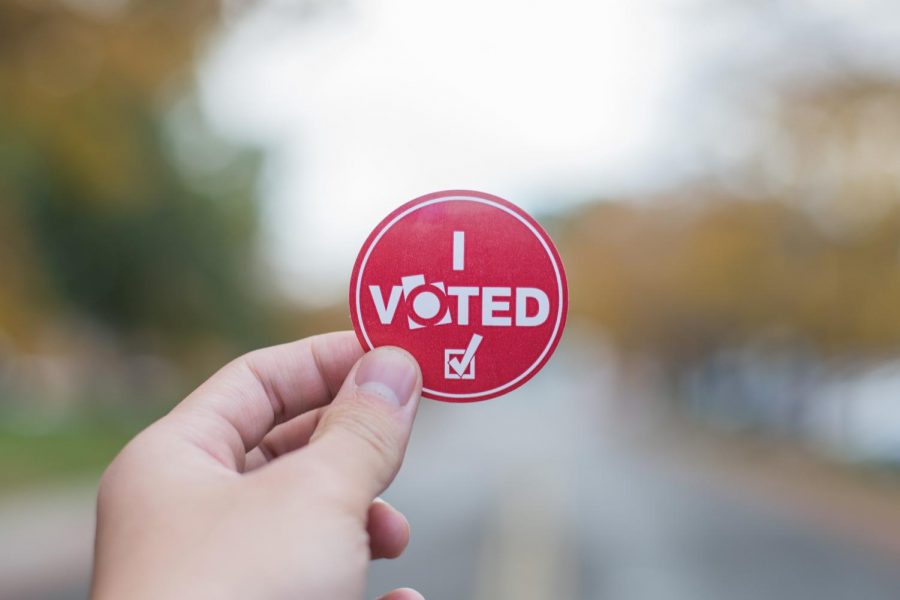Young People Vote in Midterms at Second Highest Rate in 30 Years Despite Barriers
November 21, 2022
Sydney Kincart worked at the Daily Utah Chronicle from Fall 2020 to Spring 2022. In this story, she is speaking in her role as a student ambassador of the Andrew Goodman Foundation and as a junior studying political science.
In the 2022 midterm elections, 27% of young people (18-29) voted, likely the second-highest youth turnout rate for a midterm election in the past 30 years, according to an early estimate from the Center for Information and Research on Civic Learning and Engagement at Tufts University, also known as CIRCLE. The turnout is only second to the 2018 midterms when 31% of young people who are eligible to vote cast a ballot.
Early data also suggests that young voters played a key role in Democrats maintaining control of the Senate and winning other midterm elections.
Data from The All In Campus Democracy Challenge, which aims to increase many different types of civic engagement in college students, will be released in the coming months. In 2020, 57.9% of eligible U students voted in the election. This is about 8% lower than the 2020 voting rate average of all the institutions they track this data for.
In Utah specifically, obtaining accurate data on youth voter turnout is difficult for organizations like CIRCLE that aren’t government entities or political parties because of two laws passed in 2018, S.B. 74 and H.B. 218. These laws allow voters to opt-out out of publicly releasing their voter registration data.
Because of this, in 2020 CIRCLE was unable to produce any estimate for Utah, which will also be the case for 2022, according to Kelly Beadle, impact and outreach manager for CIRCLE.
“We suspect that younger people are more impacted and underrepresented [by this] because it’s on the voter registration form, which is filled out when moving or registering for the first time — something that young people do more often than older people,” Beadle said.
Sydney Kincart, a junior studying political science at the U, said she’s not surprised about the high level of turnout in this year’s election.
“I feel like this election is kind of a weird one because we’re finally coming out of COVID and then with Roe being overturned … it’s [also] a post-Trump election,” said Kincart, who’s a student ambassador for The Andrew Goodman Foundation, a national group that works to increase young voter turnout. “There were just some factors that we haven’t like seen come into play so I think that affected these midterms.”
On the other hand, Kincart explained that the two elections she and a lot of people her age remember clearest, 2016 and 2020, can give a lot of context for how college voters may feel overall.
“I wasn’t energized about either of those candidates and a lot of young people weren’t particularly wild about either of those candidates,” she said. “When the only people on the ballot are old people who you think are entirely unrelatable … why [would] you feel incentivized to vote for them if they aren’t even gonna prioritize the issues you care about?”
Kincart said she thinks it’s possible this upward trend in youth voter turnout could continue. “For so long, there were so many obstacles and barriers, and for so long, it was pretty grim,” she said. “But with this election, I think it shows that Gen Z is making change.”
In the election, Maxwell Frost was elected as the first Gen Z member of Congress to represent Florida’s 10th Congressional House District, which Kincart said is promising and gives her hope for the future.
Low Youth Voter Turnout Historically
Dr. John Holbein, co-author of the 2020 book, “Making Young Voters: Converting Civic Attitude into Civic Action,” found that in 2016, 90% of young voters reported an interest in politics, yet only 43% of them actually ended up voting in the election. According to CIRCLE, that number was 50% in 2020 (CIRCLE calculated 39% of young voters voted in 2016).
Holbein, also an associate professor of public policy, politics and education at The University of Virginia, said people should feel excited about higher rates of youth participation but made the point that it’s important to somewhat mute that excitement because many of the structural things that stop young people from voting still haven’t changed.
“We’re still seeing that young people are going through the same civics education programs, navigating the same voting systems, with some changes being the exception rather than the rule,” Holbein said. “We still see that young people have a lot of obstacles that stand in their way.”
Holbein said he thinks there are two main reasons that young voters, historically, don’t always follow through on their political interest.
“[First], young people find the voting system to be daunting, intimidating and overwhelming,” Holbein said. He added that one of the biggest things he and his co-author found in the process of writing this book is that when states make it easier to register to vote, that causes young people to follow through on their political interest more often.
“When they allow for things like same-day registration or registering to vote preemptively online, those things really help young how people overcome this sort of gap between wanting to participate and actually executing their participation,” he said.
As of 2022, 22 states and Washington, D.C., including Utah, have implemented same-day voter registration. The COVID-19 pandemic forced almost every election jurisdiction in the country to expand access and make voting easier and safer including the inclusion of 24-hour early voting sites and increasing mail voting options.
James Curry, a political science professor at the U, said mail-in voting is really good for getting people to vote and was very effective in 2020, but it’s not as convenient for younger people. “[Young people] are more transitory, they move around so if you don’t update your voter registration with a new address, it gets sent to the wrong place,” Curry said.
The second reason, Holbein said, is that young people, especially college students, are in an especially busy and less stable time of their lives. “They tend to be moving around a lot and with that comes a need to re-register and need to find a new polling location,” Holbein said. “Their lives are just in a tumultuous period, they might be moving for school and becoming familiarized with the area.”
Curry said another factor in low youth voter turnout is the limited amount of civic education taught across the country, which he believes doesn’t spend enough time explaining to young people what the government is, what it does and why it’s important.
“Civic education should be something that we start teaching in grade school,” Curry said. “That doesn’t mean you have to talk about the nasty side of politics to your first-graders, but you can teach them about things like, ‘what is government for? What is a democracy? Why do we participate? How do things work?’”
If schools taught this year after year, Curry believes it could have a huge impact long-term as these kids grow up. “If we want to have civic-minded citizens, then [there] has to be a focus on our children’s education,” he said. “And it’s not just a Utah problem — that’s a nationwide problem.”
Kincart agreed that civic education classes could further prioritize teaching students about the process of voting and how to get more civically engaged with their communities but noted it’s a very fine line to walk in the currently very politicized K-12 system.
“Just with book bans and people not being able to read about their identities,” she said. “I’d get weary of like, giving teachers those responsibilities or accepting teachers to encourage that kind of like activism and engagement because I’m really worried of how it would be received by others.”
Kincart said she doesn’t think the reason young voters don’t get out to the polls is just because of political apathy, falling in line with Holbein’s core argument in his book that young voters not being interested in politics isn’t the problem.
“I think there’s a lot of political disillusionment with our generation … people our age all lived through the Trump administration [as teenagers].”
Although young voters can be hard to get out to the polls, Kincart said youth are civically engaged in many other ways like organizing and attending protests, promoting social media campaigns and writing to elected officials. She added that she remembers being amazed as a high schooler by all the movements that young people were organizing and participating in.
“That was so cool and I think there was like a huge sense of community built around that,” she said.
Curry said that at least anecdotally, it seems to him that youth are more engaged in organizing and protests than ever, but he noted younger people have always been more inclined to take political action in the form of protest.
“What I always say is every way of participating is good. Voting, donating, volunteering, organizing, protesting, reaching out to your elected officials … but don’t just do one of them, do as many of these things as you can,” Curry said.
Social media, Kincart said, can be an incredibly impactful tool in educating young people about different social issues even if some use it to make a half-hearted attempt to post about an issue once and don’t take it any further than that.
“It’s something a lot of people can participate in,” she said. “It’s a way to start the conversation, to build passion and to build interests. And I think it can lead towards involvement on getting people to register to vote, getting people to sign up to attend the protests, or getting people to do like a letter writing campaign or email their legislators.”
Holbein said another factor in lower youth participation, particularly in midterm elections, is who political campaigns choose to reach out to, which tends to be who they think are the easiest on-the-fence voters to turn out.
“And the marginal voters, the people who could maybe get nudged by mail, a phone call or text message, tend to not look like young people,” Holbein said. “To be honest, they see mobilizing young people as too gargantuan of a task.”








